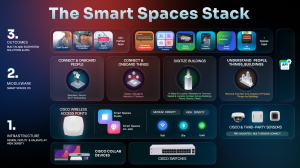
Smart buildings harness the power of advanced technology to enhance building management and significantly improve the occupant experience. This marks a transformative era in how buildings operate and interact with their inhabitants. The growth of this technology has been rapid, reshaping expectations and capabilities within modern structures. Let’s delve into the trends anticipated to influence smart buildings.
Top 10 Smart Building Trends to Watch in 2025
1. Advanced IoT Integration in Smart Buildings
The Internet of Things (IoT) is becoming the cornerstone of smart buildings. It facilitates real-time data collection and enables advanced levels of automation that were previously unattainable. By integrating IoT devices, disparate building systems can be interconnected. This enhances operational efficiency through seamless communication and enabling comprehensive real-time monitoring. This convergence of technology and infrastructure promises to revolutionize building management, making environments more responsive and efficient.
2. AI & Machine Learning for Predictive Maintenance
Artificial Intelligence (AI) and machine learning are playing a pivotal role in predictive maintenance. This significantly reduces downtime and prolongs the lifespan of building equipment. These technologies empower systems to identify anomalies and foresee potential issues before they manifest. Doing this facilitates preemptive actions that enhance operational efficiency and generate substantial cost savings. By analyzing trends and performance data, AI and machine learning transform maintenance strategies from reactive to predictive, marking a leap forward in smart building management.
3. Real-Time Data Analytics for Optimizing Building Performance
Real-time data analytics is vital in providing actionable insights that optimize energy consumption, bolster security measures, and enhance overall operational efficiency in smart buildings. By leveraging data analytics, facility managers are equipped with the knowledge to make informed decisions, leading to continuous improvements and adaptations to the building’s performance and occupants’ needs. This strategic use of data not only promotes sustainability but also fortifies building intelligence, ensuring a dynamic and responsive infrastructure.
4. Energy Optimization & Sustainability
The push for energy optimization in smart buildings centers on reducing consumption and bolstering sustainable practices. This is critical in today’s environmentally conscious world. Smart buildings are embracing energy-efficient systems and advanced technologies, such as LED lighting, smart HVAC systems, and energy management software. This helps them shrink their carbon footprint and slash operating costs. Efforts like these not only support sustainability but also deliver long-term economic benefits by cutting down on energy waste.
5. Enhanced Indoor Air Quality Monitoring
The trend towards integrating advanced air quality monitoring systems in buildings reflects a growing commitment towards ensuring healthier indoor environments. This movement is in line with the rising awareness of health and wellness within building management practices. It emphasizes the importance of clean air as a fundamental component of occupant well-being. By utilizing sophisticated sensors and control systems, buildings are now able to constantly assess and adapt to maintain optimal air quality standards, thereby supporting the health and productivity of those within.
6. Smart Security & Surveillance Systems
Smart buildings are increasingly incorporating advanced security solutions, such as AI-powered surveillance and sophisticated access control systems. These cutting-edge technologies enable enhanced safety through real-time monitoring and automated threat detection, rapidly identifying and responding to potential security breaches. By leveraging machine learning and AI, smart security systems not only provide a more secure environment but also streamline facility management by adapting to behavioral patterns and predicting security needs.
7. Integrated Building Management Systems (BMS)
The shift towards integrated Building Management Systems (BMS) marks a significant evolution in facility management, enabling centralized control and monitoring of all building systems, including HVAC, lighting, and security. By converging these disparate systems onto one platform, management is vastly simplified. This facilitates a more cohesive and efficient approach to building operations. Integration not only streamlines the management process but also significantly enhances the building’s overall performance and efficiency, making smart buildings more responsive to the needs of their occupants and the environment.
8. Data-Driven Occupant Experience & Space Utilization
Data-driven solutions are revolutionizing the occupant experience by analyzing patterns in space usage and optimizing building layouts to better meet user needs. Technologies like Cisco Spaces’ Smart Workspaces enhance this process by providing real-time analytics and insights. By interpreting data on how spaces are utilized, these technologies enable more informed decisions on space management, ensuring buildings are not only more efficient but also more adaptive to the requirements of their users.
9. Augmented & Virtual Reality for Building Management
The emerging use of Augmented Reality (AR) and Virtual Reality (VR) in building management is transforming tasks such as virtual inspections, remote troubleshooting, and training. These technologies allow building managers to interact with digital representations of physical spaces and systems, considerably streamlining maintenance and repair processes. With AR and VR, managers can virtually navigate through the building, identify issues, and perform tasks without being on-site, enhancing efficiency and effectiveness in building management.
10. Edge Computing in Smart Buildings
Edge computing revolutionizes building management by bringing data processing closer to the site, dramatically reducing response times and minimizing latency. This shift enables buildings to make real-time decisions and gain immediate insights without the reliance on continuous cloud connectivity, crucial for maintaining uninterrupted operation of critical building functions. By processing data locally, edge computing ensures that building systems like security, lighting, and climate control can operate more reliably and efficiently.
Benefits of These Trends for the Smart Building Industry
Operational Efficiency & Cost Savings
Automation and data analytics are pivotal in reducing operational costs and improving resource management within building operations. These smart technologies minimize the need for manual intervention, which frees up building managers to concentrate on high-value tasks and strategic planning. Additionally, by automating routine tasks and utilizing predictive analytics, buildings can enhance energy efficiency and optimize maintenance schedules, further driving down costs and improving sustainability.
Enhanced Occupant Health & Well-Being
Wellness-focused innovations, including advanced air quality monitoring, are essential in promoting healthier indoor environments, directly impacting the well-being of occupants. Features like these, which prioritize the health and comfort of individuals, are becoming increasingly crucial for tenant satisfaction in commercial real estate.
Support for Sustainability & Reduced Carbon Footprint
Smart buildings play a pivotal role in contributing to sustainability goals by optimizing energy use, leveraging technologies such as IoT sensors and intelligent management systems. This aligns with meeting stringent regulatory standards and also supports corporate environmental objectives. Smart infrastructures such as these are designed for efficiency, ensuring that resource utilization is precisely aligned with actual needs, thus reducing the ecological footprint and promoting a more sustainable future.
Cisco Spaces’ Role in the Future of Smart Buildings
Smart building technologies hold immense potential to drive growth, efficiency, and sustainability, as they foster intelligent resource management and operational optimization. Cisco Spaces harnesses the power of your Cisco network hardware (Catalyst, Meraki) and sensors to make your buildings safe, smart and sustainable, creating seamless experiences for the people in them. It enables organizations to significantly enhance building efficiency, improve occupant experience, and achieve sustainability objectives. It accomplishes this without the need for additional IoT gateways, streamlining technological integration and reducing complexity.
For building owners and facility managers looking to navigate the evolving landscape of smart buildings, Cisco Spaces provides an invaluable toolset. By offering data and analytics, the platform allows for a comprehensive understanding of building operations and occupant behavior. These insights are crucial in making informed decisions that drive efficiency and meet environmental standards. It offers solutions designed to streamline building operations, from predictive maintenance to space optimization. By integrating AI, IoT, and advanced data analytics, it enables buildings to adapt to occupancy patterns, reduce energy consumption, and lower carbon footprints. This future-proof approach also ensures high return on network investments. Cisco Spaces ensures that buildings are not only ready for the challenges of today but are also future-proofed for the innovations of tomorrow.
Explore Cisco Spaces solutions through an intelligent product tour to see why it is at the forefront of the smart building revolution.


